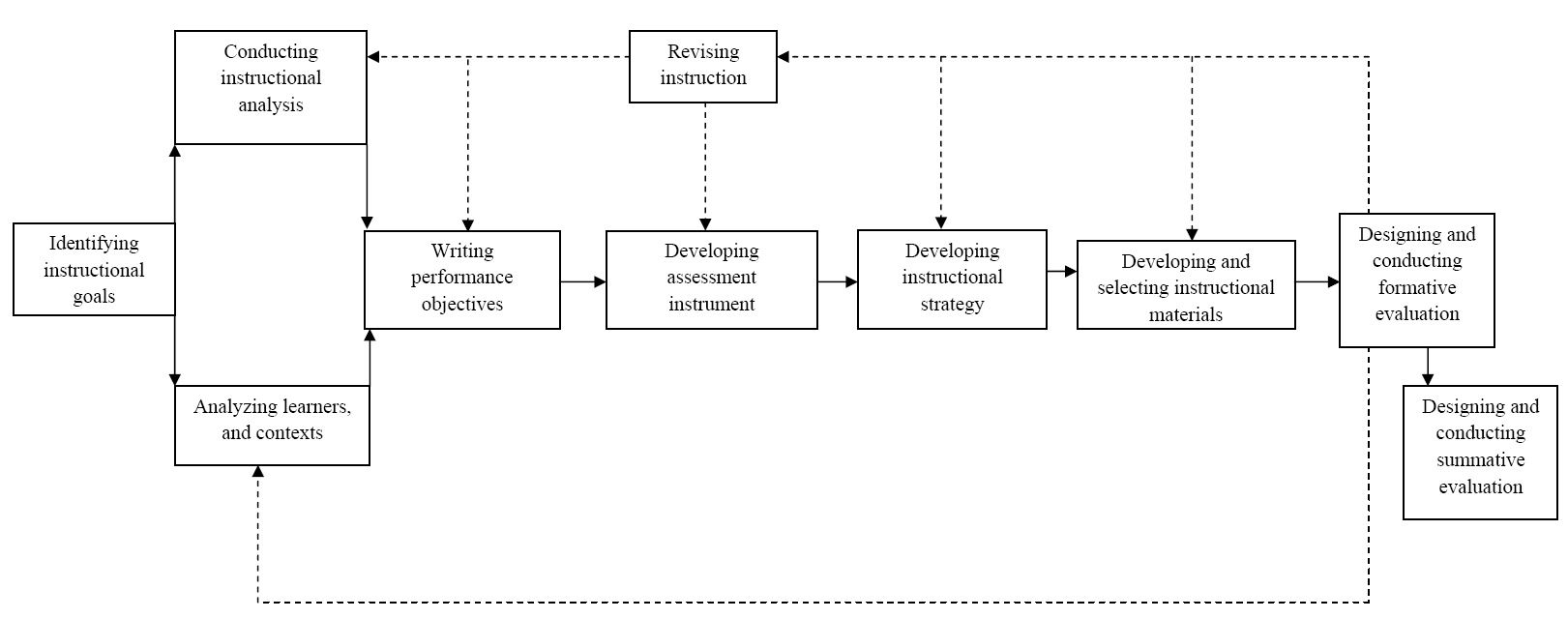I. Introducción
En la Universidad parece que las aguas llegan a su nivel. Obviamente, nos tomas un poco por sorpresa y no es muy cómodo tratar de presentar la clase sincrónicamente.
Por tanto, al decidir cambiar la clase a asincrónica tomé varios recursos de secciones previas. En específico, dedicaremos tiempo a comprender cómo y por qué surgen los modelos de DI. Y finalmente, algo que les debía de la sesión del 20 de octubre… Otros modelos de DI.
II. Cómo y por qué surgen los Modelos de DI
Grabación de noviembre del 2020:
Copia de la Presentación:
[flipbook pdf=”http://misalonweb.org/media/wp-content/blogs.dir/2/files/1634/58/Modelos-DI-copy-2020.pdf”].
III. Materiales de Referencia
A. Artículo Reiser, 2001
IV. Algunos Modelos de DI
Modelo Dick and Carey: Dick, W., Carey,L. and Carey, J. (2005) [1978]. The Systematic Design of Instruction (6th ed.). Allyn & Bacon. pp. 1–12.

Dick and Carey actual
 –
–
Modelo ASSURE: Heinrich, R., Molenda, M., Russell, J. D., & Smaldino, S. E. (1999). Instructional media and technologies for learning. Upper Saddle River, NJ: Prentice-Hall.

Modelo Gerlach & Ely: Gerlach, V. S., & Ely, D. P. (1980). Teaching & Media: A Systematic Approach (second ed.). Englewood Cliffs, New Jersey: Prentice Hall, Inc.
![Serious Game Theory [Katrin Becker, PhD]](http://www.minkhollow.ca/becker/lib/exe/fetch.php?w=&h=&cache=cache&media=resources:illustrations:slide7_demo.png)
Modelo Hannafin & Peck: Hannafin, M. J., & Peck, K. L. (1988). The design, development, and evaluation of instructional software. New York, London: Macmillan Collier Macmillan.![Serious Game Theory [Katrin Becker, PhD]](http://www.minkhollow.ca/becker/lib/exe/fetch.php?w=&h=&cache=cache&media=resources:illustrations:slide9_demo.png)
Modelo Knirk & Gustafson: Knirk & Gustafson (1986). Instructional technology: A Systematic approach to Education.

Modelo de Jerold Kemp (Morrison, Ross & Kemp): Kemp, J. E. (1985). The instructional design process. New York: Haper and Row.

Rapid Prototyping Model: Tripp, S. D., & Bichelmeyer, B. (1990). Rapid protoyping: An alternative instructional design strategy. Educational Technology, Research and Development, 38(1), 31-44.

Bergman & Moore Model: Bergman, R.E. & Moore, T.V. (1990). Managing interactive video-multimedia projects (1st ed.). Englewood Cliffs, New Jersey: Educational Technology Publications, Incorporated
![6321bmcooperativespring2011 [licensed for non-commercial use only] / Bergman and Moore Model Overview](http://6321bmcooperativespring2011.pbworks.com/f/1299565350/bergman-moore-model.png)
Successive Aproximation Model (SAM) – Allen, M & Sites, R. (2012). Leaving ADDIE for SAM : an agile model for developing the best learning experiences. Alexandria, Va:American Society for Training and Development.

Understanding By Design (McTighe, J., & Wiggins, G. (1999).Understanding by Design professional development workbook. Alexandria, VA: ASCD.
En realidad este es un modelo de desarrollo (diseño) curricular que usa una técnica conocida como “Backward Design”

Pebble in a Pond Mode – Merrill, M. D. (2002). A pebble-in-the-pond model for instructional design. Performance Improvement, 41(7), 39-44.

V. Otras Referencias
Gustafson, K. L. (1996). Instructional Design Models. En: Plomp, T. & Ely, D.P. (1996). International Encyclopedia of Educational Technology (2nd Ed). NY: Elsevier Science, Inc. Enlace al artículo.
Gustafson, K. L. (1995). Instructional Design Fundamentals: Clouds on the Horizon.. En: Seels, B. (1995). Instructional Design Fundamentals: A Reconsideration. NJ: Educational Technology Publications, Inc. Enlace al artículo
VI. Tareas: Trabajar en tu informe final
VII. Comentarios
La sección de comentarias de la sesión está abierta por si desean comentar o hacer una pregunta.